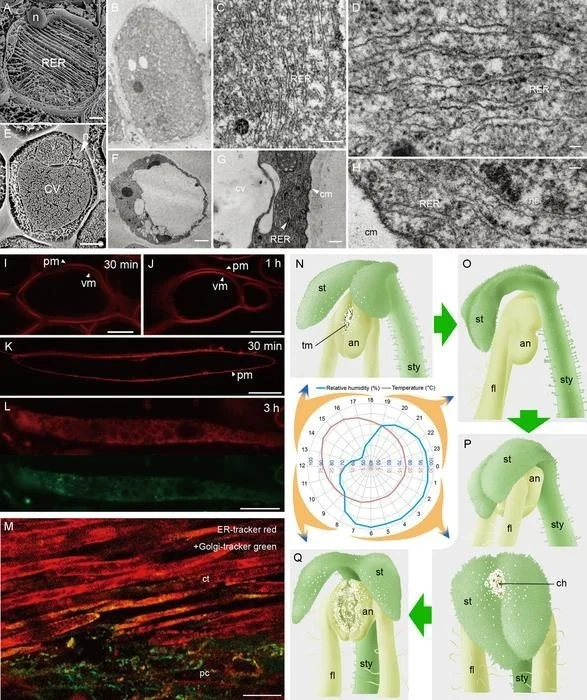Reviewed by Danielle Ellis, B.Sc.Aug 23 2023
Dr Yin-Zheng Wang of the Chinese Academy of Sciences' Institute of Botany is the lead of the study team that discovered movement in the Chirita pumila stigma and established a link between the motion and water sensitivity. Additionally, it was discovered through anatomical research that the “contractile cells,” which make up half of the stigma’s volume and are directly associated with the extension-contraction movement of the stigma, significantly expanded when the stigma absorbed water.
 A-H, Contractile cells in Cryo-SEM/TEM (A-D) and parenchymal cell (E-H); I-L, Contractile cells (K, L) and parenchymal cell (I, J) in CLSM with FM4-64 fluorescence signal; M, ER-tracker red and Golgi-tracker green fluorescence signal in stigma through CLSM; N-Q, Stigma movement and self-pollination associate with circadian rhythm of humidity. Image Credit: Science China Press
A-H, Contractile cells in Cryo-SEM/TEM (A-D) and parenchymal cell (E-H); I-L, Contractile cells (K, L) and parenchymal cell (I, J) in CLSM with FM4-64 fluorescence signal; M, ER-tracker red and Golgi-tracker green fluorescence signal in stigma through CLSM; N-Q, Stigma movement and self-pollination associate with circadian rhythm of humidity. Image Credit: Science China Press
The study team discovered that parenchyma cells mostly consist of large central vacuoles via Cryo-SEM, whereas contractile cells are filled with reticular structures, and the nuclei were pressed to the margins. The contractile cells substantially extend to more than eight times after absorbing water and are still packed with a network structure.
This demonstrates that the primary mechanism of water sensitivity is the reticular structure, which drives contraction cell elongation and stigma movement through water absorption and expansion. However, there was no vacuole membrane signal in contractile cells, and the weak signals at various red and green wavelengths revealed a significant elongation of the contractile cells.

Image Credit: Kikujiarm/Shutterstock.com
CLSM demonstrated that FM4-64 fluorescence signals migrated from the plasma membrane to the vacuole membrane in the parenchyma cells. It is proven that the water-sensitive component that absorbs water and expands is a network structure rather than a vacuole since contractile cells lack vacuoles.
The network structure was created by the endoplasmic reticulum with granular ribosomes, which was fully distinct from parenchyma cells, according to TEM and fluorescence signal analysis. The expression patterns of constricted cells were considerably different from those of parenchyma cells, according to an RNA-seq study.
The scientists discovered through field observation that the plant’s stigma had a bidirectional opening and closing-bending action and that the contractile cells controlled the stigma's circadian rhythm in response to variations in humidity.
Additionally, the movement of the stigma creates a pollen channel that runs between the two stigma lobes, squeezing the anther and forcing pollen onto the receptive side of the stigma through this channel.
Thus, the movement of the stigma changes a floral system that relies on insect cross-pollination into one that strictly relies on self-pollination. This unique proximal method of reproductive assurance, which involves a shift from outcrossing to mostly self-pollination, reflects a reproductive strategy that most likely developed in response to the unstable environment for insect cross-pollination that Chirita pumila experiences.
Source:
Journal reference:
Wang, Y.-Z., et al. (2023). A new type of cell related to organ movement for selfing in plants. National Science Review. doi.org/10.1093/nsr/nwad208